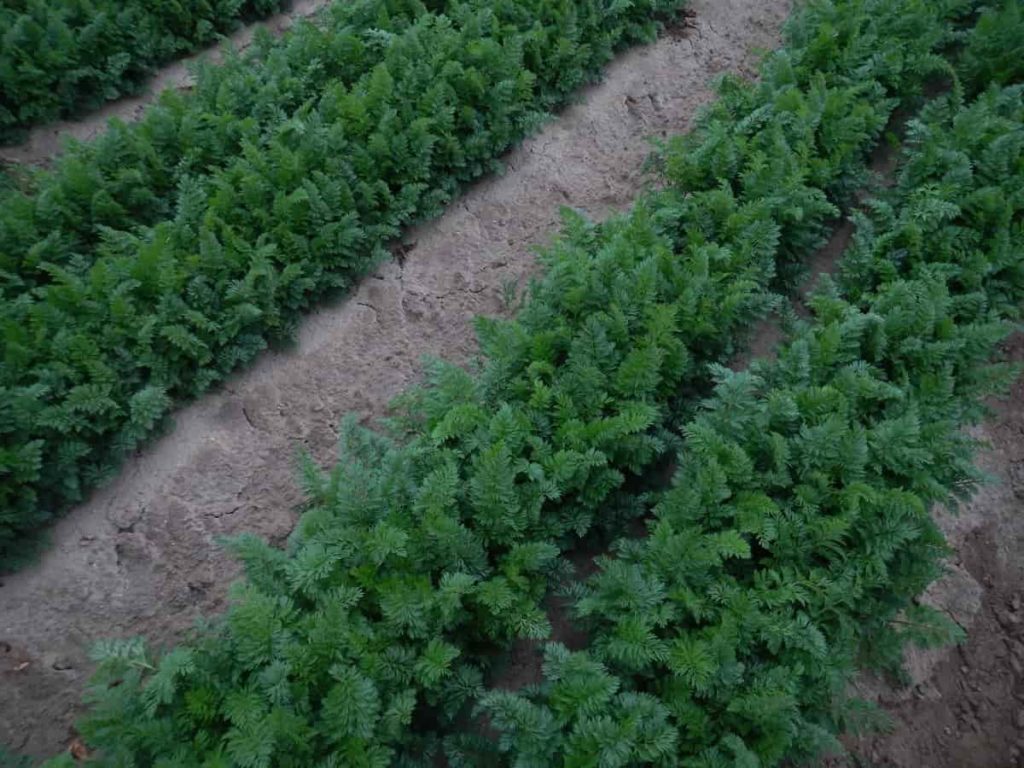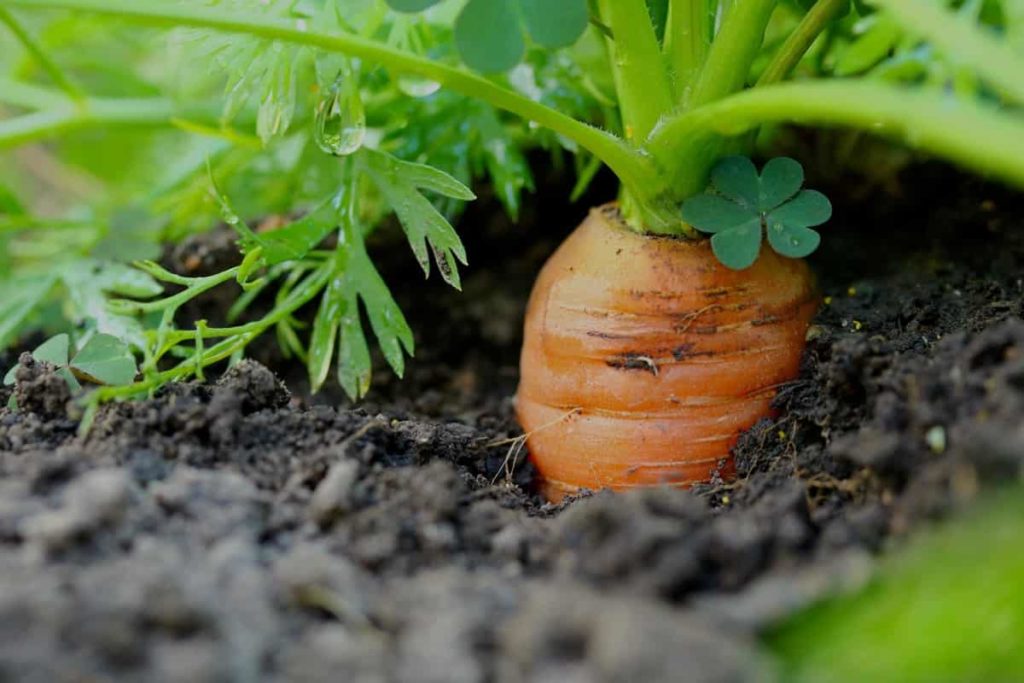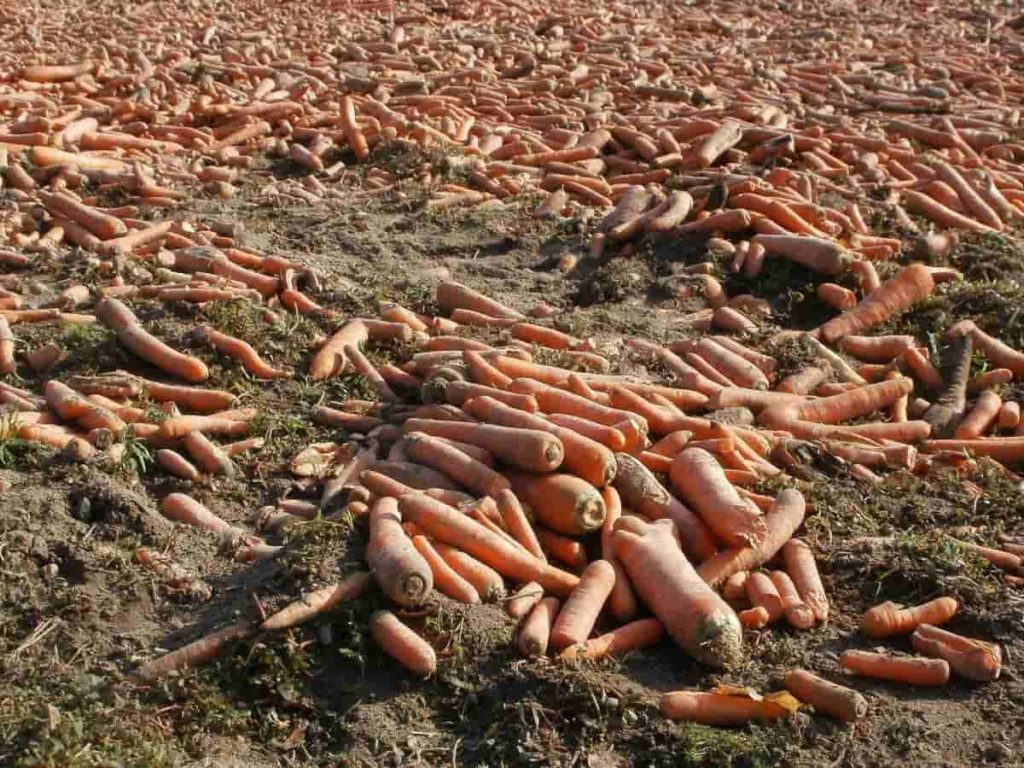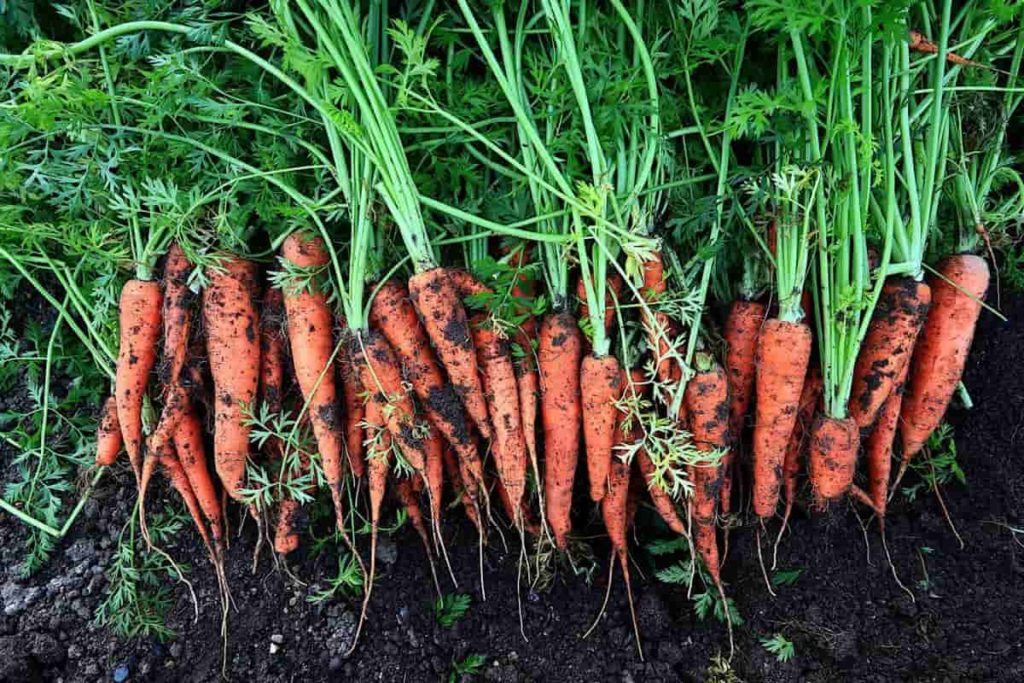Nothing beats the taste of freshly picked Carrots from the garden. They’re crunchy and sweet, and you have a selection of varieties and colors you can’t find in the supermarket. In general, Carrots require minimal attention during the growing stage. You should maintain the best pH level of soil and feed your Carrot plants with some mulch or organic nutrients.

In addition, make sure you water plants regularly to maintain their oxygen levels so that Sclerotinia sclerotiorum fungus does not grow white mold cover on your Carrot roots. Most Carrots are about an inch in diameter and anywhere from one to more than 12 inches long. Carrots are famous for long, orange roots but come in many colors and shapes.
How to grow Carrot from seed to harvest
How long do Carrots take to grow from seed to harvest?
- Long, straight Carrots need to be planted in deep, loose, and sandy soil without any stone. If you have compact or rocky soil, plant this root vegetable in raised beds or containers.
- Carrots seeds take 12 to 15 days to germinate. If it’s cold, like in early spring, don’t give up if you don’t see it sprouting right now. Carrots take a long time to reach maturity. Although you can pull and eat Carrots at any time, the best size for flavor and texture is the size of finger length.
- First, you can start looking for baby and globe Carrots to mature in the garden about 52 to 65 days after sowing the seeds. Varieties such as Chantenay, Nantes, and Imperator Carrots take about 70 days to mature. Danvers’ Carrots take closer to 75 days of planting before they are ready.
- The Carrots should be ready for harvesting 70 to 80 days after planting. When the roots are 1 to 1 and 1/2 inches in diameter, pull them out of the soil. Loosen the soil around the Carrot with a spade to avoid breaking the Carrot while pulling.
In case you missed it: Homemade Fertilizers for Root Vegetables: Potatoes, Carrots, Beetroot, Onions, Radishes, Turnip, Ginger, and Garlic

How many Carrots will I get from one seed?
- A Carrot seed produces a plant, and since a Carrot is the edible root of the plant, a seed produces only one Carrot.
- The production and quality of Carrots depend on the variety, time of sowing, type of land, etc. Its early crop yields an average of about 20 to 25 tonnes per hectare in August, the medium crop yields 30 to 40 tonnes from September to October, and the last crop yields 28 to 32 tonnes per hectare in November.
When should I start Carrot seeds?
- You can sow Carrot seeds from early spring to late summer for a harvest that will last almost year-round, so they form an essential part of almost every vegetable garden. The first important trick with Carrot seeds is to sow them shallowly and then maintain moisture in that upper layer of soil until they germinate.
- Carrots grow best in cold temperatures in early spring and late autumn. For growing Carrots, a night temperature of 13°C and a day temperature of 23°C is ideal.
How do you germinate Carrot seeds quickly?
- Carrot seeds are naturally slow-growing, but you can speed things up a bit by priming the seeds indoors. Start three to four days before you plan to sow them, soak the Carrot seeds in water for an hour, and then transfer them to a damp paper towel. Fold the seeds to close, then place the air inside the closed container.
- The best temperature of the soil for growing Carrots is 7°C to 30°C. Carrot seeds can take 14 to 21 days to germinate. Since Carrot seeds are small, they need to be sown shallowly. The trick is to keep the upper layer of soil moist during a relatively long germination period.
- Carrots are slow to germinate and sometimes won’t sprout if the soil temperature is too low.
In case you missed it: 18 Common Carrot Plant Problems: How to Fix Them, Solutions, and Treatment

How can you tell when Carrots are ready for harvesting?
- Baby Carrots are usually ready for harvesting 50 to 60 days from the planting date. Mature Carrots require a few more weeks and are usually ready in about 75 days. Most Carrots are ready for harvesting when the shoulder is 1/2 to 3/4 inches, but there is a lot of variation depending on the types.
- There is no mystery in harvesting Carrots, though many pick them too early or leave them in the field until they get woody because they are not sure when to harvest them. Carrots mature 60 to 70 days after sowing, as long as they are thinned enough and get plenty of water.
- Depending on the different varieties, they take about two to four months to mature, and you can plant Carrots for a continuous harvest throughout the spring and summer. So, with frequent sowings, you can enjoy fresh Carrots from late spring to autumn. Harvest as soon as they’re big enough to use, don’t aim for the largest roots, or you’ll sacrifice the taste.
Do Carrots come back every year?
- However, Carrots are biennials. Therefore, if you leave the Carrot roots in the ground, the tops will flower next year and produce Carrot seeds; Carrots themselves will become bitter.
- Carrots grow continuously after planting. You can start the first harvest in mid-spring once the threat of frost is over and continue planting new seeds every two weeks for a continuous harvest through the fall. Carrot harvesting can begin when they are finger-shaped.
- Keep in mind that Carrots are a biennial crop grown as an annual. In the first season, seed-grown Carrots produce leaves, stems, and delicious roots. At this time, you usually pull them up while the roots are young and tender.
Do Carrots need full sun?
- Carrots prefer full sun and well-dug, stone-free soil. Improved beds with well-rotted compost are ideal, although very recently manured beds can cause fork roots. The tops of Carrots are cold-hardy down to at least -7°C, but the roots can take even colder temperatures, especially if you pile on a thick layer of straw mulch to insulate them.
- Root crops such as Radish, Carrots can grow in at least 3 to 4 hours of direct sunlight with light or diploid shade for the rest of the day.
- Carrots prefer sunny places with 6 to 10 hours of sun. The soil must be free-draining; it is one of the few crops that actively benefits from sandier soil.
How often should Carrots be watered?
- Carrots need loamy, loose soil for the best root growth. Water immediately after planting, then give the plants an inch of water per week. When the roots start to mature, increase the amount of water to 2 inches per week.
- The best way to know this is to stick your finger into the soil about an inch deep near the plants if they need water (but don’t disturb the developing roots). If it’s moist, there’s no need for water.
- You can easily give more water to your Carrot plants if you’re not careful. Carrots grow best in moist soil that is not too wet or dry. Too much water prevents Carrot roots from absorbing enough oxygen.
In case you missed it: Carrot Planting Frequently Asked Questions (FAQs)

How long can you leave Carrots in the ground?
- You can leave the Carrots in the ground all winter, but you may want to harvest them before early spring. Once spring arrives, the Carrots will flower and become inedible.
- Carrots stored in cool, humid conditions will last for 4 to 6 months. Carrots exposed to very cool temperatures will become bitter tasting. Carrots left too long in the ground will be hard, woody, and can burst. Check the roots while storing and remove those that start to deteriorate.
- If you fail to harvest the Carrots in the allotted time, the tops will eventually flower, making them inedible.
Do Carrots need fertilizer?
- Carrots, like all root crops, require plenty of potassium-rich natural fertilizers. Too much nitrogen or uneven soil moisture will cause the forking and split roots.
- Carrots need fertilizer if your garden doesn’t have enough nutrients. A good fertilizer can provide nutrients for your Carrots to grow. Carrot plants should choose fertilizers low in nitrogen and more in phosphate and potassium.
- Once the plants have emerged, scatter two tablespoons of fertilizer per 10 feet row near the plants when the tops are about 4 inches high. If the top turns yellow, fertilize again when the top is 6 to 8 inches.
- Choose soft, humus-based soil with a pH of 6.0-6.8, and feed your plants regularly throughout the season to ensure good growth. Try using a potassium-rich liquid feed for fortnightly or slowly released fertilizer.
What plants well with Carrots?
- Leeks are the bests companions for Carrots because they repel Carrot flies, and Carrots repel Leek moths. Therefore, planting Leeks and Carrots together can help plants grow without pests being harmed.
- Beans can enrich the soil around Carrots through the nitrogen-fixing process. Nasturtium is a good companion plant for many Carrots and other plants as they repel aphids, cucumber beetles, and other insects.
- When Radish sprouts, the soil loosens, allowing Carrot roots to grow more efficiently. Radish grows faster than Carrots, so you can plant radish seeds only when you plant Carrot seeds. Rosemary (and some other herbs, such as Sage) can prevent Carrot rust flies.
How deep should soil be for Carrots?
- Dig or till deeply to give these root crops room to grow. Work the soil 12 to 16 inches deep for long-rooted varieties or choose shorter, stubbier varieties. All Carrots require soil free of weeds, grass, rocks, sticks, and other debris.
- Planting more than ½-inch deep is too much to break the Carrot seedlings. Carrot seedlings will die if they can’t break the soil’s surface to get sunlight.
How big should Carrot seedlings be before transplanting?
You must wait till your Carrot seedlings are about two inches high before transplanting. Some people do the first thinning when the top is about 2 inches long and then a second thinning when they are 4 inches long. You can do this if you want. If the top part of the root of the Carrot is exposed to sunlight, its color will deteriorate. Thin the plants at a distance of thumb width.
Why are my Carrots growing multiple roots?
Excess nitrogen (more than fertility) can cause Carrots to form multiple roots or become hairy. If you add manure-filled fertilizer to your soil, do so in the fall, then let it stay in the winter before planting Carrots in the spring. The roots of the Carrot will also grow hairy in the water-logged ground.
Why are my Carrots all tops and no bottoms?
- If they don’t collapse within a short time of planting and somehow manage to grow, they bolt straight into the flower and fail, all top and no bottom.
- Too much nitrogen will give you beautiful, large green Carrot tops and decrease Carrot root growth or multiple or hairy roots. The difficulty of Carrot plants can also be the result of overcrowding. Therefore, carrots need to be thinned early.
In case you missed it: Carrot Growing Tips, Ideas, Secrets, and Techniques

How do you speed up growing Carrots?
- Heavy soil is the reason Carrots do not form or grow well. Heavy, clay soil does not allow good-sized roots to form, and the roots are twisted. If your soil is dense, lighten it with well-decomposed manure before adding sand, broken leaves, or planting.
- Carrots are further tastiest if they are allowed to mature in temperatures between 15°C to 21°C. Provide soil, fertilizer, and moisture conditions conducive to the rapid growth of roots to accelerate their growth.
How do you prepare the soil for Carrots?
- Pre-moistening the soil helps the seeds stick and does not blow around. Cover the seeds with ¼-inch fine soil or compost, then gently water.
- When you grow Carrots, the soil should be sandy loam. Make sure it is well drained. Heavy soil causes Carrots to mature slowly, and the roots will become unattractive and rough. Remember that the soil should never be rocky when you grow Carrots because it leads to poor-quality roots.
- The best soil for Carrots is loose, free of debris and clods, and either loamy or sandy. Carrots prefer full sun and relatively cool soil. In a raised bed, neighboring plants will help shade the soil and prevent it from overheating. Constant moisture produces the tastiest Carrots, so water them about 1inch per week.
Is Epsom salt good for Carrots?
- Gardeners also use Epsom salt to improve the growth of Carrots. Epsom salts have neutral pH levels, which means they won’t affect the pH of your garden soil.
- Once the actual growth occurs, mulch the Carrots with straw and water once a day on hot days, and every other day when the temperature cools down, spray them with Epsom salts and water solutions (4 cups of hot water from 1 teaspoon Epsom salt).
Should you start Carrots indoors?
- Carrots can be grown in any container, but you need to choose deep pots to accommodate your chosen type of roots. You’ll find plenty of details about the different types and varieties of Carrots, but the root length ranges from 2 inches to a foot or more, so choose accordingly.
- In each hole you should put two to three seeds, lightly cover with soil and spray with water. Keep the soil moist until the seeds grow. You should place your container in a sunny location or under growing light. Carrot seeds can take 14 to 17 days to germinate, although some may take up to 21 days.
Why are my Carrots so small and twisted?
- Deformed roots are not only caused by poor soil and also caused by disease activities called root-knot nematodes or phytoplasma asters. Nematodes are almost invisible soil organisms with food activity that can cause nodules to form on plant roots.
- If the Carrot seed is sown too thickly, and the young seedlings are not thinned enough, the plants will crowd each other, and their roots will bend, curl and twist around each other.
- Carrot fork because the growing tip of the root has been stopped or damaged by someone or something. There may be a soil insect or nematode that has nibbled at the tip of the root. Some things are likely obstacles in the soil, like small pebbles or stones.
In case you missed it: Growing Carrots In Balcony – In Pots, Planting Guide

How deep do Carrots grow?
- Plant the Carrot seeds 3 to 4 inches apart in rows in which the seeds will be 1/4 inch deep. Carrots can be planted three to five weeks before the last frost date in the spring.
- Carrots need smooth soil at depths of up to 12 inches to grow properly. Carrot roots will grow 2 to 12 inches long.
- Irrigation can affect the length of Carrots. When preparing the ground, beware of concentrating only on Carrots, edible taproot that typically ranges from 20 to 30 centimeters in length. A deep root system allows the Carrot plant to extract nutrients into the soil profile.
Conclusion
Learning to grow Carrots in your garden is worthwhile; they are easy to grow, delicious to munch on, and ready to be harvested in a few months or less. What’s more, they’re the best way to enjoy low-maintenance gardening and gain confidence if you’re a beginner.
- How to Grow Hibiscus from Flower
- Plantation Ideas for Home Decoration: A Beginners Guide
- Flower Garden Designs and Layouts for Beginners
- Planting and Spacing Techniques in Papaya: A Beginner’s Guide
- Growing Gold: Essential Techniques for Planting Pineapples
- How to Make Kalanchoe Plant Bushy: Home Remedies and Solutions
- 11 Reasons Why Your Gardenia is Not Blooming: Home Remedies and Solutions
- Eco Elegance: The Guide to Designing a Drought-Tolerant Landscape
- Gardening on a Slope: Strategies for Hillside Landscaping
- Nourish and Flourish: Top Organic Mulches for Thriving House Plants
- Everything You Want to Know about Indian Mogra Flower: Discover Uses and Growing
- Green Thumb Success: Expert Tips for Cultivating Greenhouse Pumpkins All Year Round
- Maximize Growth & Flavor: The Ultimate Guide to Companion Planting in Herb Gardens
- How to Control Rhododendron Problems Naturally: Home Remedies and Organic Ways to Fix Them
- Natural Magic: The Remarkable Benefits of Cinnamon for Plants
- Best Steps to Revive Dying Tulip with Natural and Organic Treatment
- 10 Reasons Why Your Angel Trumpet is Not Blooming: Remedies and Treatment
- How to Fix Periwinkle Leaf and Flower-Related Problems: Natural Remedies and Solutions
- How to Fix Zinnias Leaf and Flower Problems: Discover Natural and Home Remedies
- Organic Steps to Induce Lemon Tree Flowers: A Comprehensive Guide
- Bloom Booster: Crafting the Perfect Homemade Bougainvillea Fertilizer
- Optimizing Growth: A Guide to Applying NPK Fertilizer for Potted Plants
- 10 Best Homemade Fertilizers for Rubber Plant: DIY Recipes and Application Method
- How to Boost Female Pumpkin Flowers: Effective Steps for More Flowers and High Yields
- Transform Your Indoor Garden: Top Benefits of Pink Salt for Houseplants
- 10 Best Homemade Fertilizers for Peacock Plants (Calathea): Easy DIY Guide
- Unlock Blooms: 9 Reasons Why Your Potted Chrysanthemum is Not Blooming
- 8 Reasons Why Your Potted Hibiscus is Not Blooming: Fix it with Simple Solutions
- Unlock Blooms: 9 Key Reasons Your Potted Frangipani Won’t Flower
- 10 Reasons Why Is My Ice Plant Not Blooming: Remedies and Treatment
- 10 Reasons Why My Potted Hydrangea Not Blooming: Treatment and Remedies
- 10 Reasons Why is My Wisteria Not Blooming: Remedies and Treatment
- 10 Reasons Why is My Goldfish Plant Not Blooming: Remedies and Treatment
- Maximize Your Space: Ultimate Guide to Balcony Gardening with Grow Bags
- 10 Reasons Why Your Iris is Not Blooming: Remedies and Treatment
- 10 Reasons Why Your Anthurium Plant is Not Blooming: Treatment and Remedies